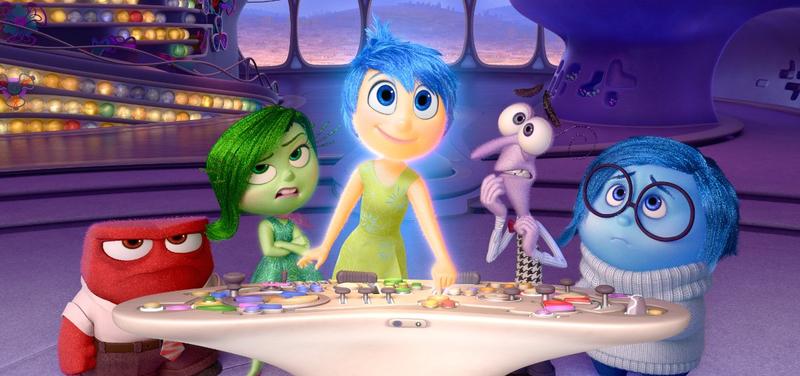
Inside Out
Pixar returns after a 1 year gap with this literal look inside the mind of a child, Riley. We see her emotions personified into Joy, Anger, Fear, Disgust and Sadness.
The initial few minutes of Inside Out set the scene out in a simple, easy to digest manner. We see Riley at her birth and the simultaneous birth of her simplest emotions, which take control of her. Memories are created and assigned an emotion, represented by a colour, then stored. It’s almost heavy-handed by Pixar standards but this approach quickly starts to make sense as the film goes on.
Everything goes swimmingly until Riley gets knocked for six with a move to San Francisco; a far cry from her native Minnesota. Her friends and interests all get up-rooted and she considers running away. Meanwhile inside, her emotions are equally out of whack as Joy gets knocked off the controls by a traumatic event.
What a beautiful, original, heartfelt piece of work this is. Docter delves deep into the human condition while somehow pulling off an entertaining family adventure. It’s best not to think too much about the logic of what’s going on; just like the real brain, the actual processes that create memories and personality are fuzzy and chaotic.
Inside Out isn’t afraid to make choices that will make people cry out ‘that doesn’t make sense!’. That’s because it has instead chosen to operate on a higher plane, exploring the reasons behind our actions and reactions to certain events, our motivations in life and dealing with trauma. If you’re worrying that they only picked five emotions to deal with, you’re missing the point.
The film runs mostly on metaphor, and with that it visits previously unexplored territory in children’s cinema. For instance the suggestion that sadness can often be what helps us through difficult times is not something that sells Minion toys in happy meals; but the film makers don’t seem to care. It’s OK to be sad. Sometimes it’s the only way we can feel anything at all.
There’s also a running commentary on how memories affect every part of our lives, from our current mood, our personality, to how we interact with other people. Docter manages to explain the importance of memories, and equally the importance of loading them with emotion. Simply by changing the ‘colour’ of a memory he’s saying that what one remembers is always defined by how one remembers.
The real stroke of genius is that these relatively complex themes are set to the bright, colourful backdrop of Riley’s mind. The set design and art direction are gorgeous and tie the whole thing together nicely. Pixar seems to be the only major animation studio that genuinely cares about how every frame looks, and here that attention to detail only adds to the film.
One other more ‘technical’ aspect that stands out is the inspired choices for the voice performances. These people haven’t been picked because they are big names, it’s because they fit the bill perfectly. Amy Poehler and Phyllis Smith play Joy and Sadness respectively and their work is a large part of what makes the film so memorable.
On a personal level, I found this to be one of the most fascinating, profound experiences I’ve had from a film. There is so much more to talk about, so much more to be uncovered, that I feel like I cannot do it justice in words.
Another smart, entertaining, emotional masterpiece from the studio.